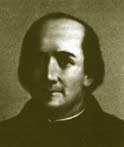
 |
| Jesuit map of Lake Superior (or Tracy). (map by anonymous cartographer, 1671) enlarge |
These people are hunters and warriors, using bows and arrows, rarely muskets, and never [bark] canoes. . . . They have no forests in their country, but vast prairies instead, where oxen, cows, deer, bears, and other animals feed in great numbers. (Claude Allouez, 1667)![]()
In 1666, a group of eighty Illinois Indians traveled northward on a trading expedition from their homeland in the central Mississippi River valley. Their destination was a small French Canadian trading post and mission located at Chequamegon Bay on the southwestern shore of Lake Superior. Here they met with Father Claude Allouez, a black-robed Jesuit priest, who became the first of many Europeans to meet face-to-face with the Illinois Indians. Allouez learned that the Illinois had formerly been a nation with a large population divided into ten large villages. However, costly wars with the Iroquois and Dakota (Sioux) had reduced their numbers.
![]()
Father Jacques Marquette, Jesuit priest. (portrait by John A. Nielson)
Illinois traders made additional trips to Lake Superior during the next few years to obtain guns, gunpowder, kettles, hatchets, and knives. Father Allouez and other missionaries admired their calm disposition and viewed them as good candidates for conversion to Christianity. Father Jacques Marquette, a newly ordained Jesuit priest who began ministering to the Great Lakes Indians in 1666, longed to establish a mission among the Illinois. In preparation, he studied their language and learned what he could of their culture while operating missions on Lake Superior and on the north shore of the Mackinac Straits between Lake Michigan and Lake Huron.![]()
|
|
Copyright © 2000 Illinois State Museum
